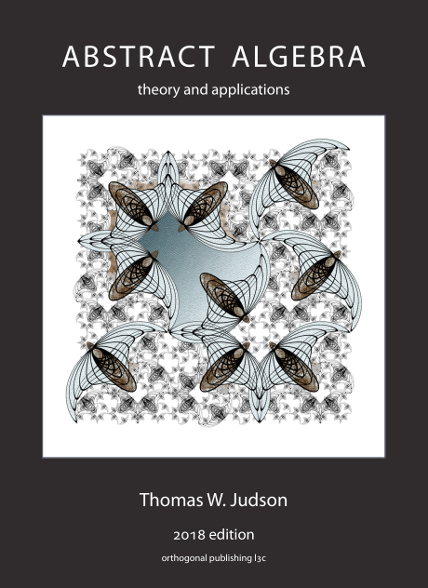Section 4.2 Integral Domains and Fields
Let us briefly recall some definitions. If \(R\) is a ring and \(r\) is a nonzero element in \(R\text{,}\) then \(r\) is said to be a zero divisor if there is some nonzero element \(s \in R\) such that \(rs = 0\text{.}\) A commutative ring with \(1 \neq 0\) is said to be an integral domain if it has no zero divisors. If an element \(a\) in a ring \(R\) has a multiplicative inverse, we say that \(a\) is a unit. If \(1 \neq 0\) and every nonzero element in a ring \(R\) is a unit, then \(R\) is called a division ring. A commutative division ring is called a field.
Example 4.12.
If \(i^2 = -1\text{,}\) then the set \({\mathbb Z}[ i ] = \{ m + ni : m, n \in {\mathbb Z} \}\) forms a ring known as the Gaussian integers. It is easily seen that the Gaussian integers are a subring of the complex numbers since they are closed under addition and multiplication. Let \(\alpha = a + bi\) be a unit in \({\mathbb Z}[ i ]\text{.}\) Then \(\overline{\alpha} = a - bi\) is also a unit since if \(\alpha \beta = 1\text{,}\) then \(\overline{\alpha} \overline{\beta} = 1\text{.}\) If \(\beta = c + di\text{,}\) then
Therefore, \(a^2 + b^2\) must either be 1 or \(-1\text{;}\) or, equivalently, \(a + bi = \pm 1\) or \(a+ bi = \pm i\text{.}\) Therefore, units of this ring are \(\pm 1\) and \(\pm i\text{;}\) hence, the Gaussian integers are not a field. We will leave it as an exercise to prove that the Gaussian integers are an integral domain.
Example 4.13.
The set of matrices
with entries in \({\mathbb Z}_2\) forms a field.
Example 4.14.
The set \({\mathbb Q}( \sqrt{2}\, ) = \{ a + b \sqrt{2} : a, b \in {\mathbb Q} \}\) is a field. The inverse of an element \(a + b \sqrt{2}\) in \({\mathbb Q}( \sqrt{2}\, )\) is
We have the following alternative characterization of integral domains.
Proposition 4.15. Cancellation Law.
Let \(D\) be a commutative ring. Then \(D\) is an integral domain if and only if for all nonzero elements \(a \in D\) with \(ab = ac\text{,}\) we have \(b=c\text{.}\)
Proof.
Let \(D\) be an integral domain. Then \(D\) has no zero divisors. Let \(ab = ac\) with \(a \neq 0\text{.}\) Then \(a(b - c) =0\text{.}\) Hence, \(b - c = 0\) and \(b = c\text{.}\)
Conversely, let us suppose that cancellation is possible in \(D\text{.}\) That is, suppose that \(ab = ac\) implies \(b=c\text{.}\) Let \(ab = 0\text{.}\) If \(a \neq 0\text{,}\) then \(ab = a 0\) or \(b=0\text{.}\) Therefore, \(a\) cannot be a zero divisor.
The following surprising theorem is due to Wedderburn.
Theorem 4.16.
Every finite integral domain is a field.
Proof.
Let \(D\) be a finite integral domain and \(D^\ast\) be the set of nonzero elements of \(D\text{.}\) We must show that every element in \(D^*\) has an inverse. For each \(a \in D^\ast\) we can define a map \(\lambda_a : D^\ast \rightarrow D^\ast\) by \(\lambda_a(d) = ad\text{.}\) This map makes sense, because if \(a \neq 0\) and \(d \neq 0\text{,}\) then \(ad \neq 0\text{.}\) The map \(\lambda_a\) is one-to-one, since for \(d_1, d_2 \in D^*\text{,}\)
implies \(d_1 = d_2\) by left cancellation. Since \(D^\ast\) is a finite set, the map \(\lambda_a\) must also be onto; hence, for some \(d \in D^\ast\text{,}\) \(\lambda_a(d) = ad = 1\text{.}\) Therefore, \(a\) has a left inverse. Since \(D\) is commutative, \(d\) must also be a right inverse for \(a\text{.}\) Consequently, \(D\) is a field.
For any positive integer \(n\) and ring \(R\text{,}\) we write \(n\) for the element \(1 + \cdots + 1\) (\(n\) times) in \(R\text{.}\) If \(n\) and \(m\) are positive integers, then the product of the corresponding elements in \(R\) is:
using the distibutive law, and resulting in \(nm\) terms. Therefore, the product of the elements of \(R\) denoted by \(m\) and \(n\) is the element denoted by the product of intgers \(mn\text{.}\) We define the characteristic of a ring \(R\) to be the least positive integer \(n\) such that \(n=1+ \cdots + 1=0\) in \(R\text{.}\) If no such positive integer exists, then the characteristic of \(R\) is defined to be 0. We will denote the characteristic of \(R\) by \(\chr R\text{.}\)
Example 4.17.
For every prime \(p\text{,}\) \({\mathbb Z}_p\) is a field of characteristic \(p\text{.}\) Since \(p\) is prime, every positive integer less than \(p\) is relatively prime to \(p\text{.}\) Therfore, by Proposition 3.4(6), every nonzero element in \({\mathbb Z}_p\) has an inverse; hence, \({\mathbb Z}_p\) is a field.
Theorem 4.18.
The characteristic of an integral domain is either prime or zero.
Proof.
Let \(D\) be an integral domain and suppose that the characteristic of \(D\) is \(n\) with \(n \neq 0\text{.}\) If \(n\) is not prime, then \(n = ab\text{,}\) where \(1 \lt a \lt n\) and \(1 \lt b \lt n\text{.}\) By the definition of characteristic, \(a\) and \(b\) are not equal to the \(0\) element of \(R\text{,}\) but their product \(ab = n\) is zero, which contradicts the assumption that \(D\) is an integral domain. Therefore, \(n\) must be prime.
